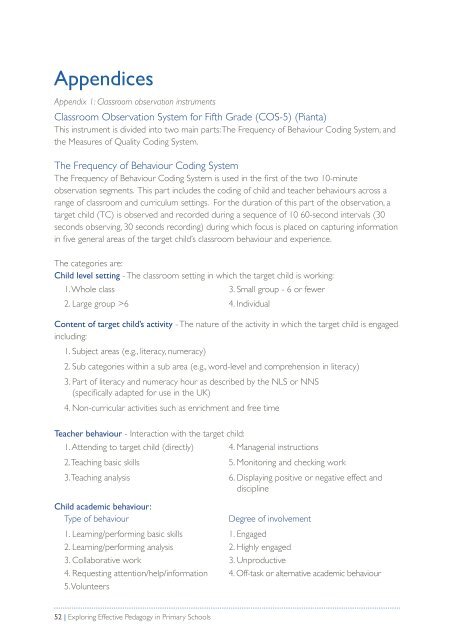Pearson-Exploring-Effective-Pedagogy-in-Primary-Schools
Pearson-Exploring-Effective-Pedagogy-in-Primary-Schools
Pearson-Exploring-Effective-Pedagogy-in-Primary-Schools
You also want an ePaper? Increase the reach of your titles
YUMPU automatically turns print PDFs into web optimized ePapers that Google loves.
AppendicesAppendix 1: Classroom observation <strong>in</strong>strumentsClassroom Observation System for Fifth Grade (COS-5) (Pianta)This <strong>in</strong>strument is divided <strong>in</strong>to two ma<strong>in</strong> parts: The Frequency of Behaviour Cod<strong>in</strong>g System, andthe Measures of Quality Cod<strong>in</strong>g System.The Frequency of Behaviour Cod<strong>in</strong>g SystemThe Frequency of Behaviour Cod<strong>in</strong>g System is used <strong>in</strong> the first of the two 10-m<strong>in</strong>uteobservation segments. This part <strong>in</strong>cludes the cod<strong>in</strong>g of child and teacher behaviours across arange of classroom and curriculum sett<strong>in</strong>gs. For the duration of this part of the observation, atarget child (TC) is observed and recorded dur<strong>in</strong>g a sequence of 10 60-second <strong>in</strong>tervals (30seconds observ<strong>in</strong>g, 30 seconds record<strong>in</strong>g) dur<strong>in</strong>g which focus is placed on captur<strong>in</strong>g <strong>in</strong>formation<strong>in</strong> five general areas of the target child’s classroom behaviour and experience.The categories are:Child level sett<strong>in</strong>g - The classroom sett<strong>in</strong>g <strong>in</strong> which the target child is work<strong>in</strong>g:1. Whole class3. Small group - 6 or fewer2. Large group >64. IndividualContent of target child’s activity - The nature of the activity <strong>in</strong> which the target child is engaged<strong>in</strong>clud<strong>in</strong>g:1. Subject areas (e.g., literacy, numeracy)2. Sub categories with<strong>in</strong> a sub area (e.g., word-level and comprehension <strong>in</strong> literacy)3. Part of literacy and numeracy hour as described by the NLS or NNS(specifically adapted for use <strong>in</strong> the UK)4. Non-curricular activities such as enrichment and free timeTeacher behaviour - Interaction with the target child:1. Attend<strong>in</strong>g to target child (directly) 4. Managerial <strong>in</strong>structions2. Teach<strong>in</strong>g basic skills5. Monitor<strong>in</strong>g and check<strong>in</strong>g work3. Teach<strong>in</strong>g analysis6. Display<strong>in</strong>g positive or negative effect anddiscipl<strong>in</strong>eChild academic behaviour:Type of behaviour1. Learn<strong>in</strong>g/perform<strong>in</strong>g basic skills2. Learn<strong>in</strong>g/perform<strong>in</strong>g analysis3. Collaborative work4. Request<strong>in</strong>g attention/help/<strong>in</strong>formation5. VolunteersDegree of <strong>in</strong>volvement1. Engaged2. Highly engaged3. Unproductive4. Off-task or alternative academic behaviour52 | <strong>Explor<strong>in</strong>g</strong> <strong>Effective</strong> <strong>Pedagogy</strong> <strong>in</strong> <strong>Primary</strong> <strong>Schools</strong>


